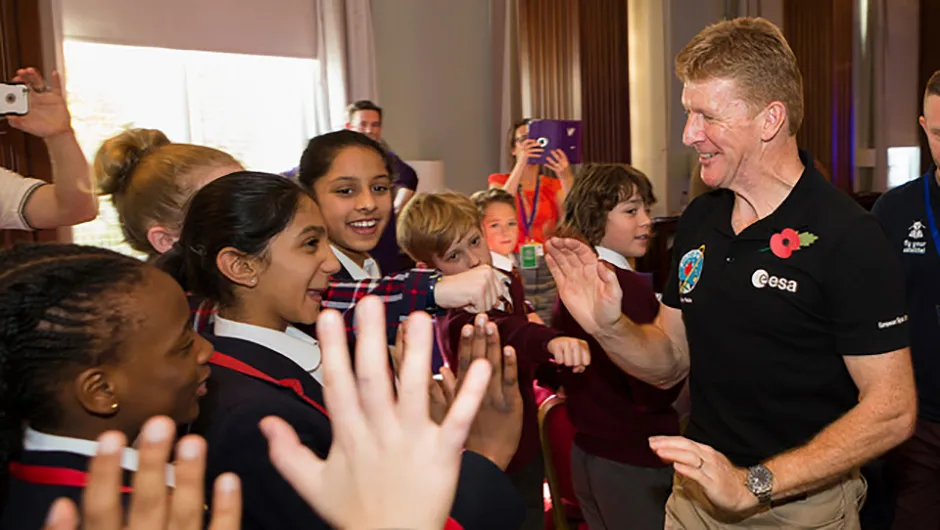Almost a year after his return to Earth following six months on the International Space Station (ISS), UK astronaut Tim Peake told the UK Space Conference in Manchester he is excited about his next space assignment.
The conference took place 30 May - 1 June 2017 at the Manchester Central Convention Complex. If all goes well, Tim will most likely experience his second spaceflight post 2019.
By August this year he will have left his assignment at Johnson Space Center in Houston to re-join the European Astronaut Centre (EAC) in Cologne and become Head of Crew Operations Support for the European Space Agency (ESA).
In this role he will work with Paolo Nespoli on the Italian astronaut's six-month Vita mission (currently scheduled for late July 2017).
In 2018 Alexander Gerst, a fellow 2009 ESA astronaut selection group member, will make his second flight to become an ISS commander.
Luca Parmitano will then launch in 2018/19, possibly at a time when crewed Space-X Dragon and Boeing CST Starliner commercial spacecraft will be resupplying the ISS.
Tim seems to be on-track to achieve his second mission post 2019, assuming the UK government continues to be part of ISS science research.
Tim Peake’s Principia mission on Expedition 46/47 was not only a science research success; it had a major and lasting importance in terms of young people’s engagement.
Over 1.6 million children were involved during its 30 educational projects, with 10,000 schools signing up and following Tim’s activities on the ISS during 2015/16.

The Overview Effect
Tim explained to the UKSC audience more about his Principia mission thrills and, in particular, his amazement at seeing the Earth 400km below from the ISS’s cupola window.
He described the classic feelings of awe experienced by astronauts at seeing the relatively few signs of habitation or urban development across Earth during daylight passes, known as the overview effect.
He also described the “alarming fragility” of the planet, with its delicate atmospheric band on the Earth’s curved horizon.
Peake talked about how the scale of Earth’s geology formations crossing continents made a deep impression on him and how seeing the Aurora Borealis and Australis, plus flashing thunderstorms at night, provided strong memories from the flight.
For Peake, the coming five years will be potentially very exciting.
The NASA deep space Orion spacecraft is due for testing shortly, attached to its massive SLS launcher.
Commercial Dragon, Starliner and Dreamchaser spacecraft will soon be operational and the emerging flights of Virgin Galactic’s eight-seat SS2, Blue Origin’s six-seat New Shepard and Xcor’s Lynx spaceplane will provide new access to sub-orbit for tourists and research scientist astronauts in the next few years.
Normality of living in space
Peake also emphasised how “normal” living in the harsh environment of space was becoming.
He believes that humanity has now almost “mastered” living in Low Earth Orbit (LEO) and one day soon the long deep-space journey to Mars will also become normal for humans.
Ever the careful astronaut and dedicated former test pilot, Peake also described how on the ISS he would cautiously carry out daily visual safety checks on the Soyuz TM19M that would return his crew to Earth.
Micrometeoroid and radiation damage, plus fuel and coolant line leaks are key worries for spacecraft exposed on long duration missions and constant checks are undertaken on the integrity of the Soyuz.
Peake was conscious that the ISS may start to experience engineering challenges beyond its 2028 design lifetime.
The station could of course be re-tasked for commercial science research and tourist visits, but deorbiting may become necessary in the late 2020s once refurbishing and repairing it becomes too difficult for the longer term.
ESA human spaceflight plans
ESA's Director of Human Spaceflight and Robotic Exploration David Parker echoed the excitement Tim Peake described for the forthcoming plans for ESA human spaceflight.
Parker outlined how Europe would continue to use the ISS for science research until at least 2024, at the same time pressing on with its contribution to the development and flight testing of NASA’s four-seat Orion deep-space spacecraft that could one day take astronauts to the Moon and on to Mars.
From 2017 ESA is operating the European Exploration Envelope Programme, a six-phase series of activities leading from ISS operations in LEO to 2024/8, medium term Orion vehicle testing with its European Service Module, unmanned interplanetary science missions including the ExoMars rover, LEO commercial science operations such as Cubesat access at 50,000 euros per satellite.
Then NASA and ESA will look at Deep Space Gateway possibilities.
The latter would be a crewed outpost in deep space, possibly at a Near Rectilnear Orbit (NRO) perhaps swinging out beyond the Moon’s orbit.
Beyond the Gateway, the ESA concept of a Moon Village is favoured for the future, as a precursor and testing ground for a sustained base on Mars.
Future UK astronauts and international plans
Despite international political changes, the ISS has proven to be perfectly workable and robust in terms of its continuing wider 17-nation cooperation, including Russian crew members and hardware since its occupation from 2000.
ESA are working with Russia for lunar research, the Luna’s 25 and 26 landers being planned for post 2019, while the idea of lunar and future Mars soil testing and analysis at UK Receiving Labs is a possibility for the future.
There is also the potential prospect of ESA links with China and its planned space station, post 2019.
This LEO station will be smaller than the ISS and will follow the Tiangong 1 and 2 prototypes, but its operation could well continue beyond the 2024/8 expiry period of the ISS.
ESA will most likely seek new astronaut candidates in new intake selection rounds, post 2020, particularly for the forthcoming Orion deep-space missions with NASA.
Assuming the UK continues to be involved in the exciting activities of human spaceflight, there could well be every prospect of new young British astronauts following Tim Peake’s lead and gaining access to space in the coming near future.
